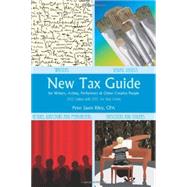
Note: Supplemental materials are not guaranteed with Rental or Used book purchases.
Purchase Benefits
What is included with this book?
The New copy of this book will include any supplemental materials advertised. Please check the title of the book to determine if it should include any access cards, study guides, lab manuals, CDs, etc.
The Used, Rental and eBook copies of this book are not guaranteed to include any supplemental materials. Typically, only the book itself is included. This is true even if the title states it includes any access cards, study guides, lab manuals, CDs, etc.
I will address the types of income a person involved in the arts might earn and introduce the most important point in the book: the difference between employment income and self-employment/contract income. In these days of multidisciplinary artists, it is common for folks to have income and expenses from both employment and self-employment. According to this differentiation, income and expenses will appear in different places on the income tax return. But first things first:What is income?
In essence, income is practically everything of value you receive in exchange for your products or services as a performer, visual artist or writer (hereafter referred to as “artist”). You can be “paid” in cash, services, or property; you can even have barter income. Taxable income may or may not be reported on a tax form such as a 1099-MISC, W-2 or K-1 at year-end. Most of you will be familiar with the first two tax forms, but perhaps not with the K-1. The form K-1 is a means of transferring income from a partnership to a partner, an LLC to a member, or an S type corporation to the stockholder. In other words, if the artist is a member of an LLC, then he or she will get a K-1 that will show their share of income from the business and this amount will be reported as income on their personal income tax return.
As well as the obvious form of cash payments for services directly performed or artwork delivered, your income may come in the form of “free” merchandise that a company gives you in exchange for a product endorsement. Actors often receive free or discounted products in exchange for the use of their name in advertisements. Musicians receive free merchandise for endorsing a particular instrument, brand of strings or other supplies. The types of activities and/or products for which an artist may receive income include:
While not exhaustive, the list gives a sense of the many activities that produce taxable income for the artist. These types of professional income will be added to your other income, whetherunearned income(such as interest, dividends, capital gains, rental income, alimony, prizes, unemployment income) or otherearned incomethat is unrelated to your professional life (for instance, the musician who moonlights as a music store clerk or the actor who works as a waiter). These types ofunearned incomeand unrelatedearned incomeare handled on your income tax return in exactly the same fashion as they would be on anybody else’s income tax return. It is with your professional income that things diverge.
What Type of Income Is It, and Why?: Employee Wages vs. Contract Income